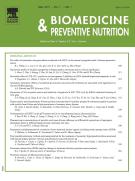Antioxidant activity and anticancer effect of bioactive peptide from enzymatic hydrolysate of oyster (Saccostrea cucullata) - 13/08/14
 , S. Meenakshi a, V. Vimalraj b, M. Arumugam a, G. Sivagami c, T. Balasubramanian a
, S. Meenakshi a, V. Vimalraj b, M. Arumugam a, G. Sivagami c, T. Balasubramanian aAbstract |
The antioxidant and anticancer activities of bioactive peptide isolated from oyster (Saccostrea cucullata) protein hydrolysate were evaluated in vitro. The oyster hydrolysate exhibited a strong antioxidant potential as a DPPH scavenger (85.7±0.37%) followed by reducing power (2.63±0.2 OD at 700nm) at a concentration of 1mg/ml. Due to the high antioxidant potential, hydrolysate was fractionated in Sephadex G-25 gel filtration chromatography and peptides were purified by UPLC-MS. Among 7 purified peptides (SCAP1–7), 3 peptides (SCAP1, 3 and 7) had the highest scavenging ability on DPPH radicals. The amino acid sequence and molecular mass of purified peptides (SCAP1, SCAP3 and SCAP7) were Leu-Ala-Asn-Ala-Lys (MW=515.29Da), Pro-Ser-Leu-Val-Gly-Arg-Pro-Pro-Val-Gly-Lys-Leu-Thr-Leu (MW=1432.89Da) and Val-Lys-Val-Leu-Leu-Glu-His-Pro-Val-Leu (MW=1145.75Da), respectively. Moreover, oyster peptide SCAP1 had anticancer activity against human colon carcinoma (HT-29) cell lines. Percentage of cell growth inhibition (MTT assay), apoptotic morphological changes (AO/EtBr staining) and oxidative DNA damage (comet assay) were estimated. We thus conclude that the anticancer and antioxidative peptide (SCAP1) from oyster (S. cucullata) may be useful ingredients in pharmaceutical and nutraceutical applications.
Le texte complet de cet article est disponible en PDF.Keywords : Oyster hydrolysate, Antioxidant, Anticancer, HT-29, Apoptosis
Plan
Vol 4 - N° 3
P. 343-353 - juillet 2014 Retour au numéroBienvenue sur EM-consulte, la référence des professionnels de santé.
L’accès au texte intégral de cet article nécessite un abonnement.
Déjà abonné à cette revue ?

